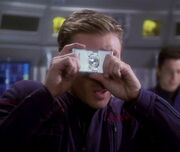| Line 2: | Line 2: | ||
== Types of cameras == |
== Types of cameras == |
||
| − | Since all |
+ | Since all cameras are multi-disciplinary (even in our own century), The type of camera is defined by its lens requirement, size and usage, such as: SL, SLR, Head cam, and all other cameras featured in Star Trek or not. |
| + | The following definition of camera types are wrong and should be corrected. |
||
| − | + | As incorrectly defined below, Single frame and multi frame are not separate type of cameras. They are a type of setting found on almost al cameras post 1970. Multi frame does not mean video, it means multiple frames are expose at the same time giving the subject matter multiple images as it passes the camera lens. |
|
PLEASE FIX THE FOLLOWING DEFINITIONS!! |
PLEASE FIX THE FOLLOWING DEFINITIONS!! |
||
Revision as of 01:42, 16 March 2013
A Camera is a device that records images that can be stored directly, transmitted to another location, or both. These images may be still photographs or moving images such as videos or movies. The term camera comes from the word camera obscura (Latin for "dark chamber"), an early mechanism for projecting images. The modern camera evolved from the camera obscura.
Types of cameras
Since all cameras are multi-disciplinary (even in our own century), The type of camera is defined by its lens requirement, size and usage, such as: SL, SLR, Head cam, and all other cameras featured in Star Trek or not.
The following definition of camera types are wrong and should be corrected. As incorrectly defined below, Single frame and multi frame are not separate type of cameras. They are a type of setting found on almost al cameras post 1970. Multi frame does not mean video, it means multiple frames are expose at the same time giving the subject matter multiple images as it passes the camera lens.
PLEASE FIX THE FOLLOWING DEFINITIONS!!
=== Single-frame camera === (WRONG)

Tucker with single-frame camera
Single-frame cameras capture one moment from one point in one direction.
In 2151, Trip Tucker used such a device to take still images on an unknown planet, later named Archer IV. (ENT: "Strange New World")
He later used one to take a photo of Jonathan Archer in his captain's chair to be sent to an artist in Oakland who was to paint a portrait of the captain that was to be placed in Starfleet Command. (ENT: "Rogue Planet")
=== Multi-frame camera === (WRONG) Multi-frame cameras, often called video cameras, capture several frames per second and store them sequentially. The frames are later displayed in sequence, changing at the same frequency that they were captured. These cameras often include audio recording capability as well, synchronizing the sampled audio with the sequence of images.
When the USS Voyager was thrown back in time and space to 1996 Earth, a man caught Voyager in low orbit with his video camera during a barbecue. (VOY: "Future's End")
In 2155, Gannet Brooks employed a head-mounted video camera. (ENT: "Demons")
In 2266, Montgomery Scott installed what appeared to be a video camera aboard the USS Enterprise to record the wedding of Angela Martine and Robert Tomlinson. (TOS: "Balance of Terror")
On 892-IV, live-action cameras were used to broadcast television programs, such as Name the Winner, in 2268. (TOS: "Bread and Circuses")
On Ekos. (TOS: "Patterns of Force")
In 2293, a journalist covering the maiden voyage of the USS Enterprise-B wore a head-mounted video camera fit with an electric light. (Star Trek Generations)
In 2367, Lieutenant Junior Grade Anthony Brevelle wore a head-mounted camera during an investigation of missing Starfleet personnel on Tarchannen III. The image data collected was later used to discover an invisible species of alien. This device could be programmed to include data in the recording, like the stardate or the time of recording. It also included a light source that could be switched on if the surroundings were too dark. (TNG: "Identity Crisis")
Holographic camera
A holographic camera, also called holo-imager or holo-recorder, takes three-dimensional images called holograms.
- See also: Holophotography.
Other references
- TOS: "Tomorrow is Yesterday"
- ENT: "Rogue Planet"
- ENT: "Shadows of P'Jem"
- ENT: "Horizon"

